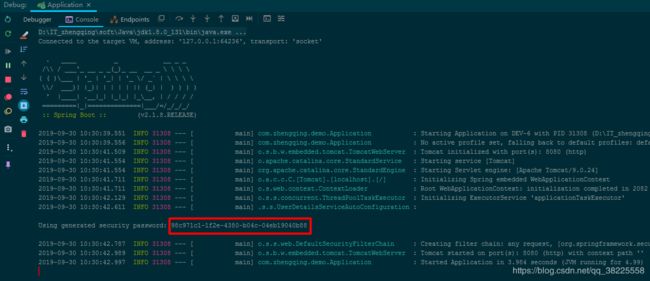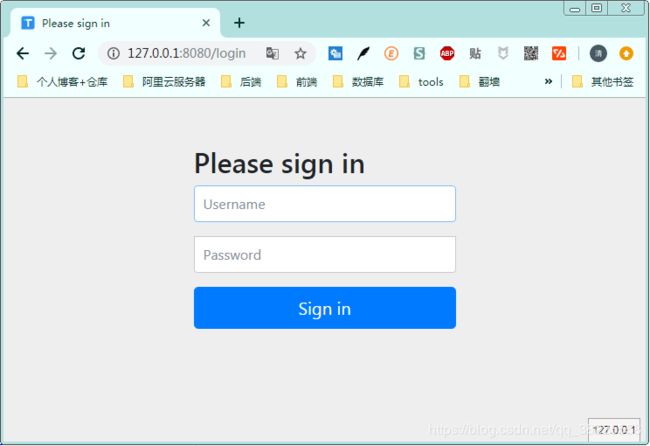一、前言
Spring Security 和 Apache Shiro 都是安全框架,为Java应用程序提供身份认证和授权。
二者区别
- Spring Security:
重量级安全框架 - Apache Shiro:
轻量级安全框架
关于shiro的权限认证与授权可参考小编的另外一篇文章 : SpringBoot集成Shiro 实现动态加载权限
https://blog.csdn.net/qq_38225558/article/details/101616759
二、SpringBoot集成Spring Security入门体验
基本环境 : springboot 2.1.8
1、引入Spring Security依赖
org.springframework.boot
spring-boot-starter-security
2、新建一个controller测试访问
@RestController
public class IndexController {
@GetMapping("/index")
public String index() {
return "Hello World ~";
}
}3、运行项目访问 http://127.0.0.1:8080/index
温馨小提示:在不进行任何配置的情况下,Spring Security 给出的默认用户名为user 密码则是项目在启动运行时随机生成的一串字符串,会打印在控制台,如下图:

当我们访问index首页的时候,系统会默认跳转到login页面进行登录认证
三、Spring Security用户密码配置
除了上面Spring Security在不进行任何配置下默认给出的用户user 密码随项目启动生成随机字符串,我们还可以通过以下方式配置
1、springboot配置文件中配置
spring:
security:
user:
name: admin # 用户名
password: 123456 # 密码2、java代码在内存中配置
新建Security 核心配置类继承WebSecurityConfigurerAdapter
@Configuration
@EnableWebSecurity // 启用Spring Security的Web安全支持
public class SecurityConfig extends WebSecurityConfigurerAdapter {
/**
* 将用户设置在内存中
* @param auth
* @throws Exception
*/
@Autowired
public void config(AuthenticationManagerBuilder auth) throws Exception {
// 在内存中配置用户,配置多个用户调用`and()`方法
auth.inMemoryAuthentication()
.passwordEncoder(passwordEncoder()) // 指定加密方式
.withUser("admin").password(passwordEncoder().encode("123456")).roles("ADMIN")
.and()
.withUser("test").password(passwordEncoder().encode("123456")).roles("USER");
}
@Bean
public PasswordEncoder passwordEncoder() {
// BCryptPasswordEncoder:Spring Security 提供的加密工具,可快速实现加密加盐
return new BCryptPasswordEncoder();
}
}3、从数据库中获取用户账号、密码信息
这种方式也就是我们项目中通常使用的方式,这个留到后面的文章再说
四、Spring Security 登录处理 与 忽略拦截
相关代码都有注释相信很容易理解
@Configuration
@EnableWebSecurity
public class SecurityConfig extends WebSecurityConfigurerAdapter {
/**
* 登录处理
* @param http
* @throws Exception
*/
@Override
protected void configure(HttpSecurity http) throws Exception {
// 开启登录配置
http.authorizeRequests()
// 标识访问 `/index` 这个接口,需要具备`ADMIN`角色
.antMatchers("/index").hasRole("ADMIN")
// 允许匿名的url - 可理解为放行接口 - 多个接口使用,分割
.antMatchers("/", "/home").permitAll()
// 其余所有请求都需要认证
.anyRequest().authenticated()
.and()
// 设置登录认证页面
.formLogin().loginPage("/login")
// 登录成功后的处理接口 - 方式①
.loginProcessingUrl("/home")
// 自定义登陆用户名和密码属性名,默认为 username和password
.usernameParameter("username")
.passwordParameter("password")
// 登录成功后的处理器 - 方式②
// .successHandler((req, resp, authentication) -> {
// resp.setContentType("application/json;charset=utf-8");
// PrintWriter out = resp.getWriter();
// out.write("登录成功...");
// out.flush();
// })
// 配置登录失败的回调
.failureHandler((req, resp, exception) -> {
resp.setContentType("application/json;charset=utf-8");
PrintWriter out = resp.getWriter();
out.write("登录失败...");
out.flush();
})
.permitAll()//和表单登录相关的接口统统都直接通过
.and()
.logout().logoutUrl("/logout")
// 配置注销成功的回调
.logoutSuccessHandler((req, resp, authentication) -> {
resp.setContentType("application/json;charset=utf-8");
PrintWriter out = resp.getWriter();
out.write("注销成功...");
out.flush();
})
.permitAll()
.and()
.httpBasic()
.and()
// 关闭CSRF跨域
.csrf().disable();
}
/**
* 忽略拦截
* @param web
* @throws Exception
*/
@Override
public void configure(WebSecurity web) throws Exception {
// 设置拦截忽略url - 会直接过滤该url - 将不会经过Spring Security过滤器链
web.ignoring().antMatchers("/getUserInfo");
// 设置拦截忽略文件夹,可以对静态资源放行
web.ignoring().antMatchers("/css/**", "/js/**");
}
}五、总结
- 项目引入Spring Security依赖
- 自定义Security核心配置类继承
WebSecurityConfigurerAdapter - 账号密码配置
- 登录处理
- 忽略拦截
案例demo源码
https://gitee.com/zhengqingya/java-workspace

